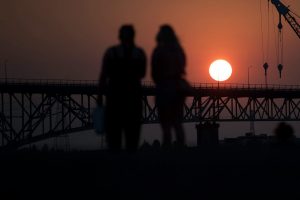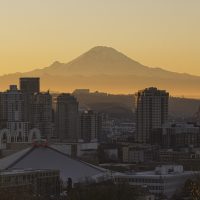One Office, Two Scientists, 100 Degrees
When temperatures rise, people turn to the Office of the Washington State Climatologist for answers.
By Haley Staudmyer for CICOES Magazine
When a heat wave in late June brought three consecutive days with temperatures exceeding 100°F, Washingtonians were in trouble. The Pacific Northwest is not built to withstand heat. Over half of all housing units in the Seattle metropolitan area are not air conditioned. Without respite from extreme temperatures, the impacts of heat on human health can be dangerous – even lethal. Citizens and city leaders alike were left wondering why this heat wave had happened, what they could do to mitigate the damage, and what to expect of future heat waves.
The state turned to the Office of the Washington State Climatologist (OWSC) for answers. The OWSC, a small office housed within CICOES, is called upon by the State of Washington to provide expert analysis of regional climate and weather patterns to state leaders, agencies, and the public. As such, Washington State Climatologist Dr. Nicholas Bond and Assistant State Climatologist Karin Bumbaco found their inboxes full and phones ringing off the hook as temperatures across the state began to soar.
“OWSC regularly talks with media, but interest in this heat wave exceeded any prior weather event,” said Bumbaco. Bumbaco and Bond received over fifty different requests from various reporters during the week of the heat wave. Their quotes appeared in The Guardian, KUOW, and twice in The New York Times, among other publications. “On the one hand, it was exciting to have that opportunity to talk with that many outlets,” said Bumbaco, “but on the other, all of our other project work came to a screeching halt.”
In every quote given, the OWSC’s message remained consistent. Bumbaco told the New York Times that a peer-reviewed analysis of the heat wave would need to be completed to understand just how much of it was related to climate change. “But it’s a safe assumption, in my view, to blame increasing greenhouse gases for at least some portion of this event,” she said. “When you have that warmer baseline, when you do get these extreme events, it’s just going to get that much warmer.” Indeed, less than two weeks later, a rapid attribution analysis with contributors from 21 different universities and research centers across the globe found that the heat wave would have been “virtually impossible without human-caused climate change.”
The OWSC has studied this subject in the past. In 2013, Bumbaco and Bond, alongside the former deputy director of the Oregon Climate Service Dr. Kathie Dello, published a paper on the historical patterns and trends of Pacific Northwest heat waves. Their research found no trend in the frequency or strength of daytime extreme heat events, which they defined as three consecutive days above a threshold. However, the data did show an increase in the frequency of nighttime heat waves. Higher minimum temperatures prevent residents from getting a much-needed respite from extreme daytime temperatures. Without a break from the heat, the risk of heat-related illnesses increases. At the time of the 2013 study, the longest-lasting nighttime event (2009) and warmest nighttime event (2006) accompanied the most heat-related hospitalizations of any heat waves since 1987.

2021’s remarkably hot summer and other recent hot years such as 2015 sparked renewed interest in heat waves at the OWSC. Shortly following the June heat wave, the OWSC enlisted the help of Oregon State Climatologist Dr. Larry O’Neill and myself to begin updating the 2013 paper to include the heat waves of the previous decade. The project is still in its early stages, but the OWSC is excited to provide an up-to-date summary of extreme heat events in the PNW that can inform local governments’ strategies for handling future events.
Both the 2013 paper and its in-progress update are motivated by the OWSC’s commitment to conducting impactful research and outreach efforts for local communities. The OWSC’s other current work includes gathering sector-specific impacts from the current drought in the Pacific Northwest and writing a regional impacts assessment report, setting up a real-time monitoring system for the Puget Sound, and quantifying the weather and climate conditions that are needed for wildfires to burn west of the Cascade Mountain crest. Their monthly newsletter rounds up the latest weather events and seasonal outlooks for the state of Washington. Bond and Bumbaco are regularly invited to speak to state agencies, emergency managers, and K-12 classrooms about Washington climate and climate change. In August and September, they presented to members of the Joint Legislative Committee on Water Supply During Drought, a bipartisan effort of the Washington State Legislature to improve the state’s response to drought conditions.
All these efforts do not go unnoticed. The OWSC is an excellent resource for local communities and a point of pride for CICOES. With their efforts, the state of Washington is better prepared to face the challenges that come with human-caused climate change.
About the author

The OWSC’s current project on heat waves in the Pacific Northwest is another example in a long history of the OWSC providing research opportunities to early-career and student scientists. I graduated from the University of Washington with a B.S. in Atmospheric Sciences this past June. I’m working at CICOES during a gap year between my undergraduate and graduate education. The OWSC has enjoyed working with other students and early-career scientists in the past on projects that include developing new web applications to better visual climate data and linking weather and climate data to incidences of vector-borne diseases in Washington State.
Working with the OWSC since June has been a wonderful experience. I interned with CICOES last summer, where I fell in love with the feeling of sinking my teeth into an interesting research project. The work felt meaningful, the team I worked with was brilliant, and my fellow interns became fast friends. It ended all too soon. Needless to say, I was thrilled when I was invited back to CICOES to work with the OWSC after graduation. Now, I am taking the lead on processing the historical temperature record data for the updated heat wave paper. As with my internship, the programming skills I’m learning on the job are much more than I could have learned during my coursework. This in-the-field experience is exactly what students and early-career scientists like me need to prepare for graduate school and beyond. CICOES and the OWSC have given me the confidence that I can succeed in whatever career endeavors I choose to pursue, and for that, I will always be grateful.

